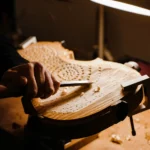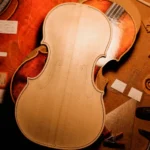Keep Playing Your Violin: What You Can Do To Take Out The Best Of Your Violin
Back to BlogPlaying the best of your violin means good practice and focus, but also care. If you are a professional violinist or just a player and want to maintain your instrument in perfect condition, live along with life, and make the best of it, there are a few things to be aware of.
Keep Playing Your Violin
Whether you’re looking to increase the value for selling it or want to ensure plenty more years playing a quality instrument, caring for your violin should become part of your practice routine. First of all, if you’re going to play the best, it’s important to have an instrument that will fit your needs, levels, and taste. The best instrument is the one that best matches with you. So the best advice is to pick the model with the proper size according to your arm.
It’s nice to create a routine after playing your violin, so that way you won’t forget so easily.
As sensitive instruments, violins should be kept in controlled environments.
Stable humidity and temperature are significant for violin storage. If left in a high humidity environment, the top and bottom plates of a violin will swell, causing the instrument’s body to increase in size and leading to the collapse of its soundpost. And it’s not just your violin. The bow’s hair is affected by weather changes as well. It can stretch in the summer and shrink in the winter.
Playing your violin beautifully, is not just about talent (of course, this is the main factor) but also, taking care of it.
The care needed will vary according to your place, but keep in mind that the temperature and humidity should be as stable as possible for your instrument. To achieve top-notch playing conditions, you should aim to maintain relative humidity at a level of between 50 and 60%. Check the humidity levels regularly to avoid problems arising from climate changes.
The humidity can cause seams to open and cracks to appear, these will make your instrument sound a bit different. To find out if there’s any unglued part in your violin, you can do minor hits throughout the surface and identify the hollow sounds. It’s very common at the top, mainly because of the sweat while playing it.
Keep an eye on the strings too.
To produce the sound that the violinist desires, the string must be set at an appropriate height. When professional musicians play, they often prefer the strings to be raised a bit higher as it creates a brighter, louder sound. However, the most important tip here is to set the strings in a comfortable way that will fit your levels as a player.
The measurements between the strings are also very important; keep them equal. The distance between the G and E strings is usually about 33mm and 34mm, a measurement you can find using a ruler.
Routine & daily care
Every violinist must remember this one!
After every practice, clean your violin with a dry flannel. Remember that sweat left to dry on the instrument can damage the varnish. This prevents the rosin from bonding to the varnish. Still, if that happens here is what you can do: try to clean it with pure turpentine’s essential oil or cleaning products specific for instruments of the violin family. This great alternative won’t damage your instrument’s varnish.
Taking your instrument with you
In order to take your violin on trips, you’ll need to do some basic maintenance, so make sure it has the proper equipment.
The same care you do at home should be done on trips. But always remember about the climate of the place you are heading to, don’t forget to check the weather.
Think of your instrument as your own baby; it will need attention and special care. And, of course, a good case is more than necessary here. No one wants scratches, right?
As good as a violin can be, once and a while, you’ll need to make adjustments and replace fittings.
We recommend you to take your violin to a luthier for a check-up every six months, just like you would do with your doctor for your health. Peg replacement will be necessary after some time of use. However, in situations where extreme changes in temperature and humidity have caused some kind of damage, it is recommended to look at them.
Also, if the way the strings have been wound affects the longevity of the pegs, you will want to be sure to unwind and wrap your strings properly to maintain peak tone quality. Strings should be replaced every nine to twelve months, even if you play only once or twice a week. But remember: the more often you play your instrument, the more frequently your strings should be changed.
Last but not least, to perform better with your violin you will need: determination and patience.
Don’t ever stress yourself out, when it gets too hard, take your time. Your feelings are reflected in your playing and your music. Don’t worry, you’ll get there if you keep practicing!
Join our newsletter to receive monthly tips directly to your inbox!









